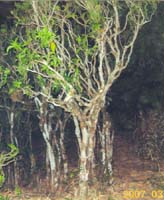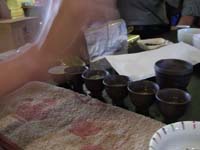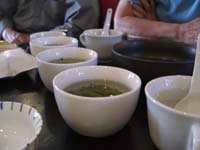I’ve been scheduling classes for the rest of the year. More may come, but here’s what I’ve got so far. If you’re in Seattle on any of these dates, I’d love to see you there! I’ll post updates to the schedule as things develop (I’m working on more classes at other venues).
25 SEP 2007: The Teas of Taiwan. Perennial Tea Room.
Only slightly larger than the state of Maryland, the island of Taiwan is known for its many varieties of wulongs (also spelled ‘oolongs’). From Bai Hao and Baozhong to Four Season Spring and Golden Lily, you can experience a wide range of flavors, oxidation levels, amount of roast, and leaf style just looking at Taiwan wulongs. Join Tea Geek Michael J. Coffey in a tasting tour of Taiwan teas. Sample a range of teas, including a far more rare Taiwan black tea, while learning about tea production and common brewing practices on the island.
6 OCT 2007: Introduction To Tea. Phinney Neighborhood Center.
What’s the difference between black and green teas? What about oolong or white? Is chamomile or mint really tea? These questions and more will be answered while you sample teas from around the world. Taught by a tea geek who’s studied tea for over 10 years, you’ll experience different brewing methods and discover interesting tidbits of tea history and culture.
13 OCT 2007: The Basics of Green Tea. Phinney Neighborhood Center.
Green tea is the most studied type of tea in the world, and the primary tea product of both China and Japan. China alone makes 3000 different kinds of green, and a uniquely Japanese green is used in their tea ceremony. Start your tea exploration with this, the original style of tea, while tasting samples from both Japan and China!
20 OCT 2007: The Basics of Black Tea. Phinney Neighborhood Center.
Black tea accounts for the majority of tea produced worldwide. Taste the differences of the various tea producing countries in an experiential class punctuated by tea trivia, history, and geography. Learn how unintentional the two major American tea “inventions†were! Find out the right way to brew and drink black tea. Is cream and sugar right or wrong?
27 OCT 2007: The Basics of Oolong Tea. Phinney Neighborhood Center.
Tea and wine author James Norwood Pratt claims that there are more kinds of oolong than wines in the world, and he may well be right. Oolong (sometimes “wulongâ€) is the most diverse category of tea. We’ll explore how oxidiation and roast levels (and other variables) influence the taste of a good oolong. Samples from China and Taiwan.
3 NOV 2007: The Basics of White Tea. Phinney Neighborhood Center.
Can’t tell a Bai Hao Yinzhen from a Bai Mudan? One of the hot new trends in the tea world is including white tea—from facial products to sweetened and flavored beverages. But what is white tea, really? We’ll sample white teas from the most traditional to the more modern and fanciful variations.
10 NOV 2007: The Basics of Puer Tea. Phinney Neighborhood Center.
This unique tea made from fermented and aged leaves is perhaps the most unusual category of true tea—at least to most westerners. Try samples of a tea used as Imperial tribute for at least a millennium! Its tendency to improve (and increase in price) with age has caused increasing interest worldwide as both a “drinkable antique†and an investment!
And coming up next year:
* JAN 2008: Cooking With Tea
* FEB 2008: The Teas of Japan
* MAR 2008: What The Heck IS Puer, Anyway?
* APR 2008: The Teas of India
* MAY 2008: Teas for Cheese
* JUN 2008: The Basics of Green Teas
* JUL 2008: The Basics of Oolong Teas



